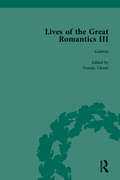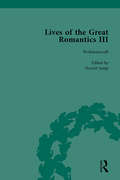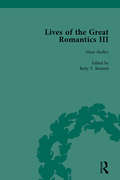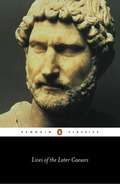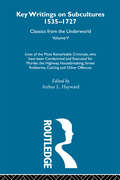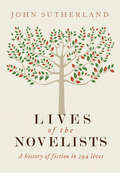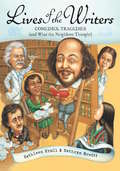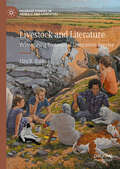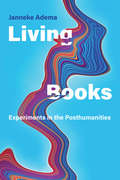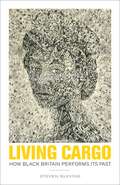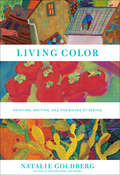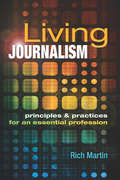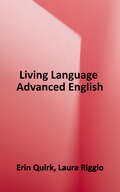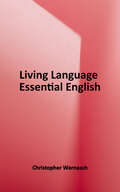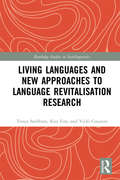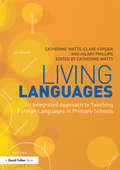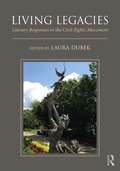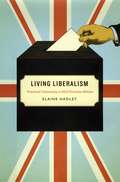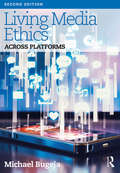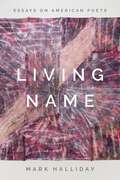- Table View
- List View
Lives of the Great Romantics, Part III, Volume 1: Godwin, Wollstonecraft And Mary Shelley By Their Contemporaries
by Pamela ClemitThis volume sheds light on contemporary perception of William Godwin, Mary Wollstonecraft and Mary Shelley, a biographically and intellectually compelling literary family of the Romantic period. The writings reveal the personalities of the subjects, and the motives and agendas of the biographers.
Lives of the Great Romantics, Part III, Volume 2: Godwin, Wollstonecraft And Mary Shelley By Their Contemporaries
by John Mullan Pamela Clemit Harriet Devine Jump Betty T BennettThis volume sheds light on contemporary perception of William Godwin, Mary Wollstonecraft and Mary Shelley, a biographically and intellectually compelling literary family of the Romantic period. The writings reveal the personalities of the subjects, and the motives and agendas of the biographers.
Lives of the Great Romantics, Part III, Volume 3
by John Mullan Pamela Clemit Harriet Devine Jump Betty T BennettThis volume sheds light on contemporary perception of William Godwin, Mary Wollstonecraft and Mary Shelley, a biographically and intellectually compelling literary family of the Romantic period. The writings reveal the personalities of the subjects, and the motives and agendas of the biographers.
Lives of the Later Caesars
by Anthony BirleyOne of the most controversial of all works to survive from ancient Rome, the Augustan History is our main source of information about the Roman emperors from 117 to 284 AD. Written in the late fourth century by an anonymous author, it is an enigmatic combination of truth, invention and humour. This volume contains the first half of the History, and includes biographies of every emperor from Hadrian to Heliogabalus - among them the godlike Marcus Antonius and his grotesquely corrupt son Commodus. The History contains many fictitious (but highly entertaining) anecdotes about the depravity of the emperors, as the author blends historical fact and faked documents to present our most complete - albeit unreliable - account of the later Roman Caesars.
Lives of the Most Remarkable Criminals - who have been condemned and executed for murder, the highway, housebreaking, street robberies, coining or other offences: Previously published 1735 and 1927 (Key Writings On Subcultures, 1535-1727 Ser. #Vol. 3)
by Arthur L. HaywardLives of the Most Remarkable Criminals was originally published in three volumes and sold by John Osborn on Paternoster Row. The volumes recount the lives, crimes and executions of eighteenth century lawbreakers. By '[setting] forth the entertainments of vice in their proper colours', the volumes were intended to provide a moral banister and reminder that, far from treading a glamorous road of pleasure, the path taken by a criminal was in fact a highway to the gallows. The original prefaces to the books, and the tales themselves, also provide invaluable insights into the history of Crown Law at the time, the grounds on which it was founded, the methods by which it prosecuted, and the judgements inflicted on criminals accordingly. This is a reprint of Arthur L. Hayward's 1927 reissue of the three volumes in one.
Lives of the Novelists: A History of Fiction in 294 Lives
by John SutherlandArranged in chronological order the novelist's lives are opinionated, informative, frequently funny and often shocking. Professor Sutherland's authors come from all over the world; their writings illustrate every kind of fiction from gothic, penny dreadfuls and pornography to fantasy, romance and high literature. The book shows the changing forms of the genre, and how the aspirations of authors to divert and sometimes to educate their readers has in some respects radically changed over the centuries, and in others - such as their interest in sex and relationships - remained remarkably constant.
Lives of the Sonnet, 1787–1895: Genre, Gender and Criticism (The\nineteenth Century Ser.)
by Marianne Van RemoortelIn a series of representative case studies, Marianne Van Remoortel traces the development of the sonnet during intense moments of change and stability, continuity and conflict, from the early Romantic period to the end of the nineteenth century. Paying particular attention to the role of the popular press, which served as a venue of innovation and as a site of recruitment for aspiring authors, Van Remoortel redefines the scope of the genre, including the ways in which its development is intricately related to issues of gender. Among her subjects are the Della Cruscans and their primary critic William Gifford, the young Samuel Taylor Coleridge and his circle, Elizabeth Barrett Browning's Sonnets from the Portuguese, George Meredith's Modern Love, Dante Gabriel Rossetti's House of Life and Augusta Webster's Mother and Daughter. As women became a force to be reckoned with among the reading public and the writing community, the term 'sonnet' often operated as a satirical label that was not restricted to poetry adhering to the strict formalities of the genre. Van Remoortel's study, in its attentiveness to the sonnet's feminization during the late eighteenth century, offers important insights into the ways in which changing attitudes about gender and genre shaped critics' interpretations of the reception histories of nineteenth-century sonnet sequences.
Lives of the Writers: Comedies, Tragedies (and What the Neighbors Thought)
by Kathleen Krull Kathryn HewittShakespeare wrote with a feather quill and ink; Emily Dickinson wrote with a fountain pen; Isaac Bashevis Singer wrote on a Yiddish typewriter. But what did such writers do when they weren't writing? What did Jane Austen eat for breakfast? What could make Mark Twain throw his shirts out the window? Why would Zora Neale Hurston punch a fellow elevator passenger? Lives of the Writers tells all that and more.
Livestock and Literature: Reimagining Postanimal Companion Species (Palgrave Studies in Animals and Literature)
by Liza B. BauerThis book explores the past and current traces that cows, pigs, chickens, and other animals used by humans have left in Anglophone literary fiction. In times of accelerated global warming, an acute pandemic, and breakthroughs in bioengineering practices, discussions on how to rethink the relationships to these animals have become as heated as perhaps never before. Livestock and Literature examines what literature has to contribute to these debates. In particular, it draws on counter-narratives to so-called livestock animals’ commodification in selected science- and speculative fiction (SF) works from the twenty-first century. These texts imagine ‘what if’ scenarios where “livestock” practice resistance, transform into biotechnologically modified, postanimal beings, or live in close companionship to humans. Via these three points of access, the study delineates the formal and thematic strategies SF authors apply to challenge anthropocentric and speciesist thought patterns. The aim is to shed light on how these alternative storyworlds expand readers’ understanding of the lives of farmed animals; seeking insight into how literature shapes human-animal relationships beyond the page.
Living Books: Experiments in the Posthumanities (Leonardo)
by Janneke AdemaReimagining the scholarly book as living and collaborative--not as commodified and essentialized, but in all its dynamic materiality.In this book, Janneke Adema proposes that we reimagine the scholarly book as a living and collaborative project--not as linear, bound, and fixed, but as fluid, remixed, and liquid, a space for experimentation. She presents a series of cutting-edge experiments in arts and humanities book publishing, showcasing the radical new forms that book-based scholarly work might take in the digital age. Adema's proposed alternative futures for the scholarly book go beyond such print-based assumptions as fixity, stability, the single author, originality, and copyright, reaching instead for a dynamic and emergent materiality. Adema suggests ways to unbind the book, describing experiments in scholarly book publishing with new forms of anonymous collaborative authorship, radical open access publishing, and processual, living, and remixed publications, among other practices. She doesn't cast digital as the solution and print as the problem; the problem in scholarly publishing, she argues, is not print itself, but the way print has been commodified and essentialized. Adema explores alternative, more ethical models of authorship; constructs an alternative genealogy of openness; and examines opportunities for intervention in current cultures of knowledge production. Finally, asking why it is that we cut and bind our research together at all, she examines two book publishing projects that experiment with remix and reuse and try to rethink and reperform the book-apparatus by taking responsibility for the cuts they make.
Living Cargo: How Black Britain Performs Its Past
by Steven BlevinsOffering a wide-ranging study of contemporary literature, film, visual art, and performance by writers and artists who live and work in the United Kingdom but also maintain strong ties to postcolonial Africa and the Caribbean, Living Cargo explores how contemporary black British culture makers have engaged with the institutional archives of colonialism and the Atlantic slave trade in order to reimagine blackness in British history and to make claims for social and political redress. Steven Blevins calls this reimagining &“unhousing history&”—an aesthetic and political practice that animates and improvises on the institutional archive, repurposing it toward different ends and new possibilities. He discusses the work of novelists, including Caryl Phillips, Fred D&’Aguiar, David Dabydeen, and Bernardine Evaristo; filmmakers Isaac Julien and Inge Blackman; performance poet Dorothea Smartt; fashion designer Ozwald Boateng; artists Hew Locke and Yinka Shonibare; and the urban redevelopment of Bristol, England, which unfolded alongside the public demand to remember the city&’s slave-trading past. Living Cargo argues that the colonial archive is neither static nor residual but emergent. By reassembling historical fragments and traces consolidated in the archive, these artists not only perform a kind of counter-historiography, they also imagine future worlds that might offer amends for the atrocities of the past.
Living Color: Painting, Writing, and the Bones of Seeing
by Natalie GoldbergEssays, art, and exercises with “many gems that will brighten anyone’s fearful mind,” from the author of the creativity classic Writing Down the Bones (The Taos News).Known as an author and sought-after writing teacher, Natalie Goldberg is also a painter whose work has been shown widely and included in prominent collections. In Living Color, she expounds on her own path to artistic inspiration, and reminds us that our explorations are not limited to only one form. Tailored to a new generation of readers who want to draw, paint, write, or express themselves through some other creative medium, this revised and expanded edition features thirteen of Natalie Goldberg’s engaging and encouraging essays with seventy-five of her paintings and twenty-two never-before-shared artistic exercises. A work of beauty and inspiration, Living Color speaks straight to the heart of anyone who wants to break down creative barriers or explore their creativity anew.
Living Journalism: Principles & Practices for an Essential Profession
by Rich MartinFor journalism to survive and flourish, it needs journalists who understand its importance to society, believe in and are committed to its core values, and can put those values into action. This goal is at the heart of Living Journalism, a highly readable, practical book where readers will learn the core values and principles needed to produce work that informs and enlightens an increasingly mobile and participatory audience. The advice and stories of professionals throughout the book allow veteran reporters to serve as mentors to today's journalists.
Living Journalism: Principles and Practices for an Essential Profession
by Rich MartinIn this readable, practical textbook Rich Martin explores the core principles and practices that beginning journalists need to produce work that informs and enlightens citizens hungry for accurate and trustworthy news. The textbook’s 16 concise chapters impart real-world examples demonstrating how the best journalists exemplify the key principles, as well as cautionary stories illustrating journalistic mistakes and missteps. It also contains exercises, checklists, tips and additional resources that students can use in class and independent study, making the book an ideal newsroom and classroom resource that can be returned to again and again for new insights. For journalism to survive and flourish in the 21st century, it needs young practitioners who understand its importance to society, believe in and are committed to its core values, and can put those values into action. This new edition of Living Journalism is an excellent updated introduction to journalism for students, teachers and young professionals.
Living Language Advanced English
by Erin QuirkEnglish, Complete Edition is a unique multimedia program that is designed for speakers of any language. It takes you from a beginner to an advanced level in one convenient package. At the core of English, Complete Edition is the Living Language Method(tm), based on linguistic science, proven techniques, and over 65 years of experience. Our method teaches you the whole language, so you can express yourself, not just recite memorized words or scripts. Advanced English is a continuation of Intermediate English. It will review, expand on, and add to the foundation that you received in Intermediate English. In other words, this course contains an in-depth review of important vocabulary and grammar from Intermediate English; an expanded and more advanced look at some key vocabulary and grammar from Intermediate English; an introduction to idiomatic language and more challenging English grammar.
Living Language Intermediate English
by Suzanne McQuadeEnglish, Complete Edition is a unique multimedia program that is designed for speakers of any language. It takes you from a beginner to an advanced level in one convenient package. At the core of English, Complete Edition is the Living Language Method(tm), based on linguistic science, proven techniques, and over 65 years of experience. Our method teaches you the whole language, so you can express yourself, not just recite memorized words or scripts.
Living Language English: Essential Edition
by Christopher WarnaschEnglish, Essential Edition is a unique multimedia introduction to English for speakers of any language. At the core of English, Essential Edition is the Living Language Method(tm), based on linguistic science, proven techniques, and over 65 years of experience. Our method teaches you the whole language, so you can express yourself, not just recite memorized words or scripts.
Living Languages and New Approaches to Language Revitalisation Research (Routledge Studies in Sociolinguistics)
by Tonya N. Stebbins Kris Eira Vicki L. CouzensThis book advocates for a new model of describing the practices of language revitalization, and decolonizing the research methods used to study them. The volume provides a comprehensive treatment of the theoretical and methodological foundations of working with communities revitalizing their languages. It lays out the conceptual framework at the heart of the project and moves into a description of the model, based on a seven-year research process working with Aboriginal communities in eastern Australia. Six case studies show the model’s application in language revival practice. The book critically engages with the notion of revival languages as emergent and ever-transforming and develops a holistic approach to their description that reflects Aboriginal language practitioners’ understandings of the nature of language. It seeks to demonstrate how the conceptual tools developed from this approach can support efforts to develop deeply collaborative research, highlight the diversity of language revitalisation practice and map between the realms of old and new, local and global, and the social, cultural, and textual dimensions of language, making this an ideal resource for researchers and scholars in sociolinguistics, linguistic anthropology, education, cultural studies, and post-colonial studies.
Living Languages: An Integrated Approach to Teaching Foreign Languages in Primary Schools
by Catherine Watts Clare Forder Hilary PhillipsLiving Languages is simply bursting with practical and original ideas aimed at teachers and trainee teachers of foreign languages in primary schools. Written by a team of experienced linguists, this book will inspire and motivate the foreign language classroom and the teachers who work within it. Living Languages comprises eight chapters and is structured around the integrated classroom, merging language learning with different aspects of the wider curriculum such as multimedia, performance, celebrations and festivals, creativity and alternative approaches to teaching languages. A DVD is also included with the book containing additional teaching materials and the associated films and audio recordings which make this a fully-developed and effective teaching resource. Over 50 real-life case studies and projects are presented, all of which have been tried and tested in the classroom with several having won recent educational awards. Ideas and activities outlined in this unique resource include: Languages across the curriculum helping to cement cross-curricular links and embed new languages in different contexts linking subjects such as history, science, PE and mathematics with French, German and Spanish; Arts and crafts projects in Languages, making and doing, including making books, creating beach huts and cooking biscuits; Languages, celebrations and festivals projects including the German Christmas market, Spanish Day of the Dead, celebrating Mardi Gras and the European Day of Languages among many others; Continuing Professional Development to inspire primary teachers to continue their individual professional development. The chapter contains concrete examples of others’ experiences in this area and includes details of support organisations and practical opportunities. Each project is explored from the teachers’ perspective with practical tips, lesson plans and reflections woven throughout the text such as what to budget, how to organise the pre-event period, how to evaluate the activity and whom to contact for further advice in each case. Activities and examples throughout are given in three languages – French, German and Spanish.
Living Legacies: Literary Responses to the Civil Rights Movement
by Laura DubekIn this timely and dynamic collection of essays, Laura Dubek brings together a diverse group of scholars to explore the literary response to the most significant social movement of the twentieth century. Covering a wide range of genres and offering provocative readings of both familiar and lesser known texts, Living Legacies demonstrates how literature can be used not only to challenge the master narrative of the civil rights movement but also to inform and inspire the next generation of freedom fighters.
Living Liberalism: Practical Citizenship in Mid-Victorian Britain
by Elaine HadleyIn the mid-Victorian era, liberalism was a practical politics: it had a party, it informed legislation, and it had adherents who identified with and expressed it as opinion. It was also the first British political movement to depend more on people than property, and on opinion rather than interest. But how would these subjects of liberal politics actually live liberalism?To answer this question, Elaine Hadley focuses on the key concept of individuation—how it is embodied in politics and daily life and how it is expressed through opinion, discussion and sincerity. These are concerns that have been absent from commentary on the liberal subject. Living Liberalism argues that the properties of liberalism—citizenship, the vote, the candidate, and reform, among others—were developed in response to a chaotic and antagonistic world. In exploring how political liberalism imagined its impact on Victorian society, Hadley reveals an entirely new and unexpected prehistory of our modern liberal politics. A major revisionist account that alters our sense of the trajectory of liberalism, Living Liberalism revises our understanding of the presumption of the liberal subject.
Living Literacies: Literacy for Social Change
by Jennifer Rowsell Kate PahlAn approach to literacy that understands it as lived and experienced in the everyday across varied spaces and populations.This book approaches literacy as lived and experienced in the everyday. A living literacies approach draws not only on such official, schooled activities as reading, writing, speaking, and listening but also on such routine, tacit activities as scrolling through Instagram, watching news footage, and listening to music. It goes beyond well-worn framings of literacy as an object of study to reimagine literacy as constantly in motion, vital, and dynamic, filled with affective intensities.
Living Masks
by Umberto MarianiThe Nobel Prize-winning dramatist Luigi Pirandello (1867-1936) is undoubtedly one of the most innovative playwrights of the twentieth century and also one of the most complex. While his influence spread throughout modernist and postmodernist works, many first-time audiences and readers are confronted with the difficulty associated with such a radical aesthetic experience. In Living Masks, Umberto Mariani presents a clear and comprehensive introduction of Pirandello's major plays for general readers, students, and scholars new to Pirandello. Functioning as a guide to understanding the fundamental themes of Pirandello's plays, the author also examines the critical, aesthetic, and technical problems associated with these plays. He provides extensive reflection on some of the failings of early and contemporary criticism on Pirandello's works and offers many corrections of interpretative direction that will be significant and helpful to directors and performers. In particular, Mariani presents a deeper understanding and greater appreciation of Pirandello's works as a challenge to the tendency to adapt, and modify them, which drastically deprive the works of their original power and beauty. A concise and accessible introduction to a twentieth-century literary master, Living Masks will be of interest to dramatists, literary scholars, and students and scholars of Italian studies.
Living Media Ethics: Across Platforms
by Michael BugejaWinner of the Clifford G. Christians Award for Research in Media Ethics, Michael Bugeja’s Living Media Ethics posits that moral convergence is essential to address the complex issues of our high-tech media environment. As such the book departs from and yet complements traditional pedagogy in media ethics. Bugeja covers advertising, public relations and major branches of journalism, as well as major schools of philosophical thought and historical events that have shaped current media practices. Examining topics including responsibility, truth, falsehood, temptation, bias, fairness, and power, chapters encourage readers to develop a personal code of ethics that they can turn to throughout their careers. Each chapter includes exercises, as well as journal writing and creative assignments, designed to build, test, and enhance individual value systems. Unlike other texts, this media ethics book ends with an assignment to create a digital portfolio with personal ethics code aligned with a desired media position or company.
Living Name: Essays on American Poets
by Mark HallidayLiving Name is a collection of essays on American poetry written by an expert practitioner of that art. Poet and critic Mark Halliday turns his attention to the work of poets who interest him because they create convincing voices of people dealing with the everyday. Instead of trying to survey the vast variety of modern poetry, Halliday considers an idiosyncratic selection of poets he finds compelling for their originality of style and exploration of human possibilities, including Walt Whitman, Kenneth Fearing, Kenneth Koch, Robert Pinsky, Rachel Wetzsteon, Tony Hoagland, Claire Bateman, and Dean Young. Each essay includes thorough close readings of individual poems, reflecting a commitment to the idea that a poem as a work of art needs to be appreciated as a unified whole. Halliday’s writing is judicious and meditative but not overly scholarly or academic. A long piece at the beginning of the book, “Poetry and the Rescue of Particulars,” argues that poems often attempt to reclaim the details of our usual routines from the chaotic confusion and noise of daily existence. The impulse to write a poem, Halliday believes, often stems from the notion that representing in poetry a sliver of human life keeps it in the world, as a trace of the vanishing moment is retained and endowed with some form of lasting reality. Throughout Living Name, Halliday enacts the allegiances that have driven his criticism for many years: to listen for genuine voices in poetry; to study whole poems, not merely passages; and to look for intelligent efforts to illuminate truths of human experience.
